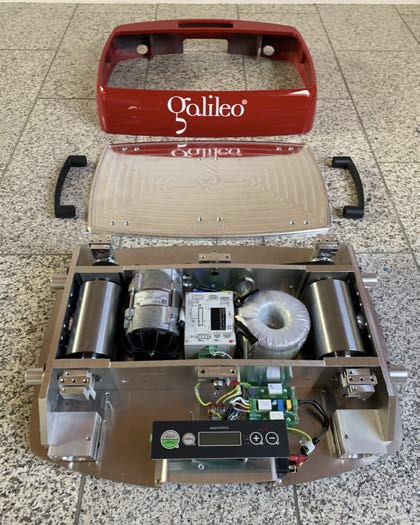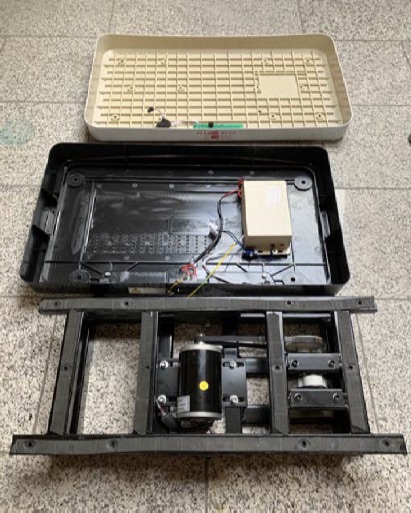We would be happy to provide you with a quote. Please contact us to discuss your specific needs so we can identify the best device for your intended use. Click here to contact us.
With over 50 different Galileo devices available for home, medical and professional use, we kindly ask you to contact us to determine the best device for your intended use, as well as the price.
Please note: with every purchase, we provide your family and local therapist (if applicable) with personalized education and the development of a customized home-based program based on your goals.
For medical, fitness and movement professionals, we provide personalized virtual education that includes:
- The science behind Galileo training
- Optimal training steps
- Training videos
- Therapy/training guidelines that complement standard exercises
- Posters
- Coaching
For home users, we provide your family and local therapist (if applicable) with personalized education, training guidelines and the development of a customized home-based program tailored to the child’s developmental stage and therapeutic goals.
We also provide training guides and educational content on our website and through social media: @GalileoJust4Kids, @GalileoTraining.
Yes; however, Galileo has different distributors in different parts of the world.
Find your local country distributor here:
https://www.galileo-training.com/de-english/contact-us/distributors-worldwide.html
“Medical device” is defined differently depending on where in the world you’re located. Produced in Germany and certifies as a medical device in many countries like the US, Canada, North America, Asia, Far East, UK, we are proud to say that Galileo products are engineered to the highest medical standards and meet the rigid criteria to be considered medical devices in these regions. Ours are the only side-alternating devices on the market that can make these claims.
That being said, not all of our devices have gone through the process of being certified as medical devices. For example, our fitness and home devices go through the same engineering process as our medical devices, but not all of them go through the same bureaucratic process.
See our engineering in the image below, and compare it to that of other side-alternating devices on the market. As you can tell, the quality of materials, the engineering, the precision technology and the features put Galileo in a class by itself.

Galileo's High Quality Difference

Other devices in medium and cheap price ranges look very similar to this
With its advanced computer interface, the Galileo platform is easy to use. The “right” frequency range for your training is largely dependent on the goal you want to achieve.
Galileo’s frequency ranges are derived from muscle physiology and neurology. There are specific average response times for the nerves in our body to react to stimuli and produce desired outcomes. This is called the speed of the nervous system.
On average, muscles need approximately 25 milliseconds (ms) to contract and 25 ms to relax, totaling 50 ms per cycle. We have designed the Galileo platform’s frequencies (Hz) based on time intervals of 1 second (1s = 1000 ms) divided by the speed of one of these cycles (50 ms). So, when we divide 1000 ms by 50 ms the result is 20 Hz, or 1 contraction/relaxation cycle per second. In other words, in 1 second at 20 Hz, you are stimulating 20 muscle contractions. No other exercise tool can provide this “massive practice” in such a short training time to amplify outcomes.
What about frequencies below 20 Hz on the Galileo platform? The muscle can still complete a full contraction/relaxation cycle per second, which is desirable when the goal is warm-up stretching, for example.
At frequencies above 20 Hz, the muscle relaxation phase is cut off, resulting in continuous and stronger muscle contractions known as co-contractions. The higher the frequency, the stronger the muscle activation – good to keep in mind when the goal is muscle building, for example.
But 20 Hz isn’t the only frequency to bear in mind. Another important frequency is 12 Hz. Here’s why: it typically takes 80-100 ms for the nervous system to send a signal from the head to the foot. At frequencies around 12 Hz, communication shifts from “spinal cord dominant” control to “brain dominant” control. On the Galileo platform, as frequencies fall below 12 Hz the stimulation effect is no longer dominant in the spinal cord; it transitions to the brain. Keep this in mind if your goal is balance, mobility or pain management.
Lower frequencies are the most difficult for deconditioned users. High frequencies over 24Hz are very important for power training and spasticity modification. Frequencies are independent of age from babies to high performance athletes.
As you can see, your therapeutic goals should determine your choice of frequencies in order to achieve your desired outcomes. And this is true regardless of your age, gender or level of conditioning.
In summary:
20+ Hz: continuous co-contraction (ideal for muscle building)
12 – 20 Hz: spinal cord dominant (warm-up stretching)
Below 12 Hz: brain dominant (balance, mobility, pain management)
Amplitude is an important, but often-misunderstood, topic. Knowing your correct amplitude allows you to train the body with proper symmetry.
To find it, start with your big toes touching at 0. You should feel little or no vibration. As you increase the width along the millimeter (mm) lines in either direction, you’ll start to feel the vibration coming into your body more intensely. One sensation is not better or worse than the other; it’s up to you to fine-tune what you want to feel and accomplish.
Everyone’s preferred amplitude is going to be different depending on their condition, goal, frequency and comfort. As a rule of thumb: when using frequencies above 20 Hz, decrease your amplitude. Research shows that in order to build strength, it’s more efficient to use lower amplitude and higher frequency. Also, high intensity training (HIT) is most efficient when you train with frequencies above 25 Hz, as the goal is to fatigue your muscles in one minute or less. So if you’re doing a squat hold to build muscle power, keep your feet close and increase your frequency to gain a greater effect in a shorter time.
Here’s a video from our friend, Master Trainer Domini Anne, on finding your amplitude: https://www.dominianne.com/galileo-new-user-tutorial
Yes, of course. We can proudly say that Galileo devices have been used in over 450 independent, peer-reviewed and published studies conducted over 26 years. Of that number, 48 studies are specifically related to children. To our knowledge, Galileo platforms are the only side-alternating devices with published studies supporting their use by children, and are the widest-studied devices of their kind on the market.
We invite you to review these studies for yourself. Many can be found on our website:
https://stimdesigns.com/research/
https://stimdesigns.com/research-common/
http://stimdesigns.com/research/research-sports/
http://stimdesigns.com/research-homewellness/
The short answer is NO.
Copycat products might claim to have the same frequency range and g force as Galileo platforms. But they don’t have Galileo’s research outcomes (which by law cannot be transferred to other companies’ devices). Which means they are definitely NOT “just like Galileo.”
When scientists conduct studies using Galileo devices, many engineering factors come into play – factors not found in other devices, involving materials, mechanics, features, safety and more. Galileo is one of few devices to have medical safety standards starting at 1 year old. IEC 60601. Manufactured in Germany done under strict International Quality standards, ISO 13485 certified by the German TUEV.
See the differences for yourself below, you’ll understand why there’s only one Galileo.
Galileo platforms are designed for people of all ages and abilities. You’re never too old or too young to benefit from Galileo’s neuromuscular stimulation – the most efficient and effective way to train. Not only will you train with less force on your body than most activities of daily living (ADLs), you’ll train in less time and with better outcomes vs. standard therapy and training! There is no other training/therapy device that provides neuromuscular stimulation by introducing the stretch reflex and cannot be replaced by any other tool. Especially valuable for hypotonic patients to strengthen the neuromuscular system and get better brain body connections in a shorter therapy/training time. Essential for hypertonic patients to reduce spasticity and build functional muscles.
- Stainless steel parts, not plastic
- A computer plate with hardware, software & firmware
- A remote control that instantly increases or decreases frequency
- Wobble variation to prevent the body from “learning” the vibration pattern
- Smart coaching to help you train within the best amplitude ranges for you
- More
The Galileo platform is the most widely-researched mechano-stimulation device on the market, with over 450 independent, peer-reviewed and published studies. The consensus of these studies – and the experience of our users – agree that the Galileo platform provides such benefits as:
- Improved muscle strength (power), coordination & function
- Increased range of motion & muscle flexibility
- Improved balance
- Higher bone mass & density
- Increased joint position, balance & proprioception
- Improved blood flow, micro-circulation & lymphatic system
- Improved sensory-motor integration & symmetry
- Greater alertness & neural communication
- Massive repetitive practice, optimizing neuroplasticity
- Reduced spasticity, management & carryover
- Improved body awareness, postural control, gait & walking speed
- Reduced contractures
- Improved mGMFM (modified gross motor function measurement) for kids with Cerebral Palsy
From the first studies published in 1998, research has shown no adverse effects from using the Galileo platform. That being said, we do advise precautions and contraindications for people with the following conditions:
- Pregnancy
- Epilepsy (due to secondary risk of injury from falls)
- Fresh fractures in trained regions of the body (10-12 weeks)
- Wound healing in trained regions of the body
- Acute stroke
- Rheumatoid arthritis (stage 3-4)
- Kidney stones & gallstones
- Acute tendinopathy in trained regions of the body
- Acute joint inflammation
- Acute thrombosis (vascular constriction)
- Acute discopathy
There are no known risks for people with:
- Pins
- Rods
- Shunts
- Baclofen pumps
- Cochlear implants
- Pacemakers
Galileo’s parent company, Novotec, has been making medical devices to study bone and muscle health since 1979. Novotec launched Galileo in 1996 to develop technologies for training the neuromuscular system, effectively pioneering the industry of whole-body vibration training.
We have thousands of locations throughout North America where Galileo devices are available for you to try. These include: clinics, gyms, hospitals, intensive clinics, movement studios, private practice therapists (adult and pediatric) and training facilities. Please reach out to find a location near you.
The science of neuroplasticity has taught us that it takes massive repetitive movement to create or change a movement pattern. It also requires doing the right exercises using correct frequency, amplitude, symmetry, postural alignment, Wobble variability, progressions, props and duration. When using the Galileo platform’s precision stimulation over time, research shows that users gain significant improvements in muscle function, strength and balance.
That being said, the Galileo platform has been used in a special long-term study with 5000+ children, including those with Cerebral Palsy, genetic disorders, diseases, etc.
In a retrospective analysis of 6 months of intensive Galileo home-based therapy followed by 6 months of standard of care therapy (E. Schoenau, C. Stark, O. Semler – Children’s Hospital, University of Cologne, Germany 2013), the Interval-Rehabilitation showed a significant positive effect on gross motor function in patients with Cerebral Palsy. And the results could be sustained after a 6-month follow-up.
The study concluded that repeated rehabilitation shows a large additional treatment effect to standard of care in 50% of children which is likely due to the intervention, because in the follow-up period (standard of care), no additional treatment effect was observed and the children followed their expected development.
We can’t speak for other products on the market, but when it comes to Galileo devices we can confidently answer NO. While there is a small percentage of the population that doesn’t particularly like the sensation of vibration, the overwhelming consensus among Galileo users is that our vibration feels really good in the body! If you feel pain while using a Galileo device, it almost always means there’s something wrong with your positioning.
Describing the sensation of vibration is like describing a color – nearly impossible to do, and highly subjective. But we like how one of our clients put it:
“At 5 Hz I sort of feel like I am a piece of seaweed wading in the ocean current. It’s very relaxing, calming, but also a lot of movement. At 12 Hz my body starts to organize together (without my conscious thought) using the body’s automatic stretch-reflex and I feel lighter, and my muscles start to hug my bones. At 25 Hz it’s exhilarating. When I get off, I feel like I’m light as a feather, floating, and have better postural control.”
We have SplitIt financing available with no credit check. Here’s how it works: You make an initial down payment, then use a MasterCard or VISA credit card for payments up to12 months. The funds are held in advance on the credit card, but they are not taken out until the respective month of payment.
If you have a medical condition, there are often many resources available to help with the funding of necessary equipment. We are happy to help you navigate the best process, depending on your state and coverage. Some of these resources include: state programs, trusts, foundations, HSAs (Health Saving Accounts), California Regional Center – Self Determination dollars, assistive technology funds, loans and more.
Insurance and state Medicaid plans are the most difficult and time-consuming, and typically have no guarantee of success. Vibration is coded as “Unclassified E1399” which attracts more scrutiny. Start by asking your case manager to help you understand requirements. Your next challenge will be finding a DME supplier to submit. These often go through denial after denial, and require a great deal of resiliency and advocacy. We see only a small percentage of successes after DME submission, even with doctor’s prescriptions, chart notes and lots of advocacy.
In recent years, another popular and effective option has emerged: crowdfunding with websites such as HelpHopeLive, GoFundMe, Kickstarter, Kiva, Patreon and Paypal.
